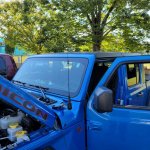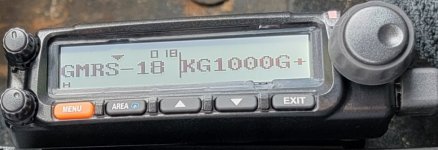Hi Everyone,
I am totally new to radios. I bought a wouxun KG1000-G Plus 50 watt mobile GMRS radio , a midland cable with NMO connector, and a matching 5/8 wave over 5/8 wave "no ground plane" midland antenna. I will be on GMRS channels that are 462 - 467 Mhz.
I bought everything from "buy two wave radios" who wouldn't answer my question about if the antenna should be grounded when I bought the antenna, and when I bought the $400 radio I asked the same question again in the notes section. They ignored the question both times and I didn't get a response.
I took it to a shop that does CB radios only to have the system installed. I think my mounting bracket that the antenna is mounted on is not grounded and that my antenna isn't grounded aside from the coax it is connected to. I wrote "I think" because the bracket is screwed into the a pillar with two painted screws. So it may be grounded but poorly. I'm not sure if the nmo mount, which is attached to the powder-coated bracket is actually electrically connected to the bracket if it happens to be poorly grounded.
My first question is: should I ground the mounting bracket and should I then make sure the NMO mount is grounded to the bracket?
The radio seems to be putting out a decent signal as I was able to be heard by my daughter with a handheld GMRS radio when I was almost 6 miles away. And the signal had to go through acres of woods and across gently rolling hills of middle Georgia. It wasn't flat land but definitely not mountains or huge hills.
My second question is: Should I make a ground plane using a copper plate under the NMO mount? If so, what is the minimum size? While the 5/8 over 5/8 wave antenna is the "no ground plane" type, where it is mounted is a good distance away from any metal underneath. It's probably 5" away from the hood of the Jeep. It's mounted on a "Ditch Light Bracket" via an extension bracket. I'd like to make sure that I am putting the strongest signal possible and I have bought a 8 x 8 copper plate and a 12 x 12 copper plate to fashion a ground plane with. Anything over 7 x 7 will be awkward to fit but I can make it work. If I use a 12 x 12" radius plate I will likely have to remove the antenna to open the hood.
I'm not opposed to going with a different style antenna. While I live in Georgia I go out to Arizona in the Payson area which has mountains, and the area near Blythe California that has mountains. So I'll be on very flat desert plains at times but also in the mountains at times. I got the radio to communicate with my daughter who'll be in the truck while I am out exploring and carrying a hand held radio. I will also have friends out exploring that I'll want to communicate with.
I discovered this forum and thought that I would ask this question here because you all will certainly have the answers. Please remember that I literally know almost nothing about radios. I've read a lot over the last couple of weeks but the antenna thing is beyond me being able to easily figure out. Thanks in advance for any help.
Attached is pictures of the antenna set-up. Supposedly the curved body piece that is immediately under the antenna is plastic - which I didn't know when I came up with this set-up. I figured that I would add a copper plate under the antenna anyways. Most of you will know that the Jeep Gladiator is nearly identical to the Jeep Wrangler and that the roof is plastic sections that come apart in 3 pieces.
I am totally new to radios. I bought a wouxun KG1000-G Plus 50 watt mobile GMRS radio , a midland cable with NMO connector, and a matching 5/8 wave over 5/8 wave "no ground plane" midland antenna. I will be on GMRS channels that are 462 - 467 Mhz.
I bought everything from "buy two wave radios" who wouldn't answer my question about if the antenna should be grounded when I bought the antenna, and when I bought the $400 radio I asked the same question again in the notes section. They ignored the question both times and I didn't get a response.
I took it to a shop that does CB radios only to have the system installed. I think my mounting bracket that the antenna is mounted on is not grounded and that my antenna isn't grounded aside from the coax it is connected to. I wrote "I think" because the bracket is screwed into the a pillar with two painted screws. So it may be grounded but poorly. I'm not sure if the nmo mount, which is attached to the powder-coated bracket is actually electrically connected to the bracket if it happens to be poorly grounded.
My first question is: should I ground the mounting bracket and should I then make sure the NMO mount is grounded to the bracket?
The radio seems to be putting out a decent signal as I was able to be heard by my daughter with a handheld GMRS radio when I was almost 6 miles away. And the signal had to go through acres of woods and across gently rolling hills of middle Georgia. It wasn't flat land but definitely not mountains or huge hills.
My second question is: Should I make a ground plane using a copper plate under the NMO mount? If so, what is the minimum size? While the 5/8 over 5/8 wave antenna is the "no ground plane" type, where it is mounted is a good distance away from any metal underneath. It's probably 5" away from the hood of the Jeep. It's mounted on a "Ditch Light Bracket" via an extension bracket. I'd like to make sure that I am putting the strongest signal possible and I have bought a 8 x 8 copper plate and a 12 x 12 copper plate to fashion a ground plane with. Anything over 7 x 7 will be awkward to fit but I can make it work. If I use a 12 x 12" radius plate I will likely have to remove the antenna to open the hood.
I'm not opposed to going with a different style antenna. While I live in Georgia I go out to Arizona in the Payson area which has mountains, and the area near Blythe California that has mountains. So I'll be on very flat desert plains at times but also in the mountains at times. I got the radio to communicate with my daughter who'll be in the truck while I am out exploring and carrying a hand held radio. I will also have friends out exploring that I'll want to communicate with.
I discovered this forum and thought that I would ask this question here because you all will certainly have the answers. Please remember that I literally know almost nothing about radios. I've read a lot over the last couple of weeks but the antenna thing is beyond me being able to easily figure out. Thanks in advance for any help.
Attached is pictures of the antenna set-up. Supposedly the curved body piece that is immediately under the antenna is plastic - which I didn't know when I came up with this set-up. I figured that I would add a copper plate under the antenna anyways. Most of you will know that the Jeep Gladiator is nearly identical to the Jeep Wrangler and that the roof is plastic sections that come apart in 3 pieces.




